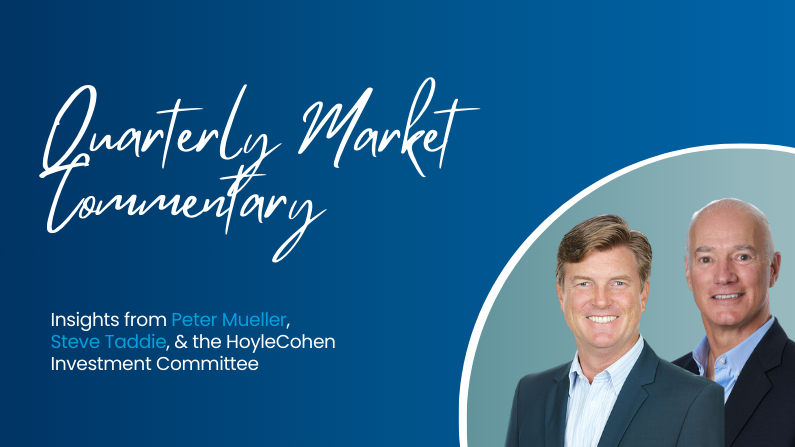The Bumpy Path Towards Normalization
By, Steve Taddie, Peter Mueller, & the HC Investment Committee
Both the economy and financial markets generated solid progress in the first quarter, with growth staying consistent and market prices rising. Employed consumers, fueled by growing “real” incomes, continue to drive consumption and thereby the US economy. The US is in a relative sweet spot with inflation normalizing (but for a few speed bumps), economic growth continuing to positively surprise forecasters, and a more balanced jobs market keeping a lid on wage pressure. Overall, rising productivity has created a framework for companies to enjoy rising profit margins and for employees to enjoy rising incomes.
The significance of the fixed-rate residential mortgages in the US, as compared to other economies around the world, remains a significant anchor to the consumer‘s willingness to spend and thereby drives economic activity. Historically, a more confident consumer is more willing to borrow against future earnings to enjoy or invest in something today. If one has a narrow focus on just one aspect of this borrowing, (i.e. revolving consumer debt is in focus), it’s easy to come to the wrong conclusion about the overall health of the US consumer. Consumer debt is a subset of overall household debt, and it is household debt service expense as a percentage of disposable income that is the more instructive view. As compared to the last 45 years, the percentage of disposable income going to pay household debt is in the lower quartile of all observations. This is important as it indicates a continued ability to consume, which facilitates economic growth.
One of the most watched data points this year will be the Federal Reserve’s short-term lending rate, the Fed Fund’s rate. When the interest rate hike cycle “paused” after September 2023, the conversation shifted to how long the pause may last. As inflation expectations eased, the pause turned into an interim ceiling, with forecasters placing their bets on when the Fed would begin to lower rates. The current expectation is for the Fed to begin cutting rates over the summer months, a 12 month pause since the last rate hike in September 2023. As compared to the less than one year pauses in 1995, 2000, and 2019, and the greater than one year pauses in the 1997-98 and 2006-2007 periods, the length of this pause will be about average. Wall Street’s unabated effort to predict exactly when the first cut will be enacted seems a bit wasted, because it is the projected trajectory that moves markets. As this unfolds, it should result in a normalized yield curve (where short-term interest rates are lower than long-term rates), lowering debt service expenses for individuals, corporations, and the US government.
With a calming of the more significant headwinds, inflation and Fed policy, coupled with the prospects for improved economic confidence, more positive expectations for both economic growth and market valuations have taken hold. Confidence among corporate CEOs continues to rise, although consumer confidence took a small step back in February’s report. Longer-term interest rates, after rising from sub 4% levels at year end, hit about 4.3%, before settling in at about 4.25% at the end of the quarter. This optimism spills over into corporate earnings expectations, as analysts expect S&P 500 companies to increase earnings per share in 2024 and 2025 by approximately 11 and 13%, respectively. These expectations have driven stock valuation levels higher. Corporate America has not been standing still for the last 3 years, and the best companies are reaping the benefits of applied technological advancements made during that time within their respective companies. Productivity has risen in the US, and investors expect continued improvements, whether based on artificial intelligence applications or more basic productivity improvements. Rising productivity will be quite important going forward for companies to continue offsetting unavoidable cost increases within their respective business operations.
American exceptionalism and the Goldilocks scenario are for continued productivity growth, continued normalization of inflation, and consistent employment with rising real wages – all key drivers of economic growth.
All the best,

Stephen J. Taddie, CBE® CFM

Peter Mueller, MBA, CFP®
For a downloadable version of this quarterly commentary click here.
The information provided here is general in nature and is shared for information purposes only; nothing herein should be interpreted as investment or tax advice. Any and all tax laws and/or specific tax rates referenced are subject to change. It should not be assumed that future performance of any specific investment or investment strategy will be profitable. Always consult your CPA/tax advisor/attorney (or reach out to us;) to discuss your specific situation. All investments carry the risk of loss, including the permanent loss of principal. Past performance is no guarantee of future results.

